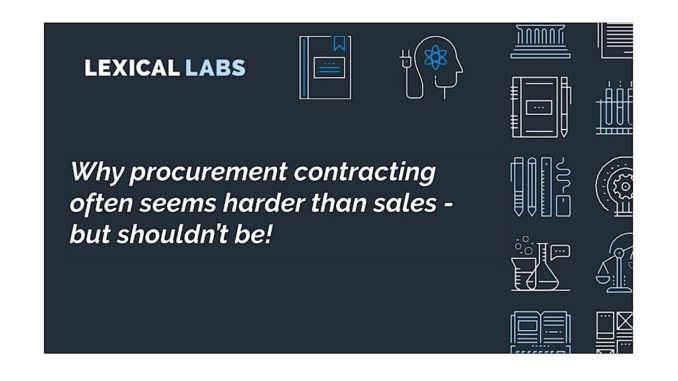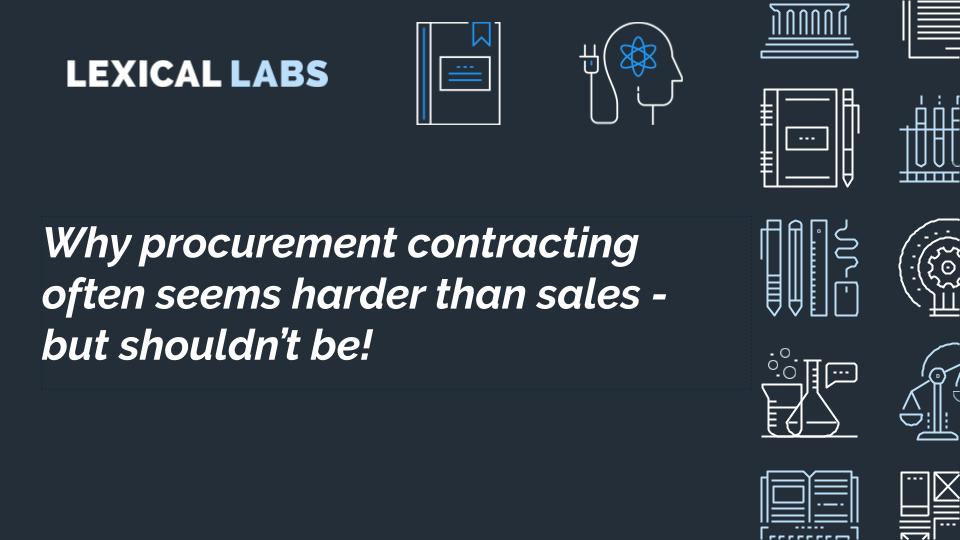
By Lexical Labs
When it comes to negotiating a contract for buying goods or services, the seller has it easy!
It is not uncommon for procurement teams, and the legal teams that support them, to be swamped with contracts of all shapes and sizes. Just knowing where to start can be half the battle.
Whatever product or service is being purchased, chances are the seller knows it inside and out. While they have probably sold and negotiated it hundreds of times before, this may be the first time the buyer has dealt with it up close. Moreover, not only is the buyer in all likelihood much less familiar with the product or service, but chances are the parties will be using the supplier’s standard terms.
A large procurement team may have well plumbed processes around supplier approval and ordering, but when it comes to the contract, everything often becomes manual.
But it doesn’t have to be this way!
Get the Basics Right
First, let’s cover the basic stuff.
The key commercial terms should be agreed before getting stuck into the contract. A term sheet or even simply an email can do the trick. Where possible, tackle the contentious points right off the bat – the more that is agreed now, the easier the contracting process will be.
Don’t reinvent the wheel. If you will be using the Supplier again, use a framework agreement. Investing the time to set up the relationship upfront will save countless hours in future.
Triage the contracts
Procurement and legal teams are typically too busy to deal with all the contracts that come through their door. Being able to quickly sift through everything that comes in and understand where the risks fall is critical.
While both sales and procurement teams can be inundated with contracts, procurement teams are likely to feel the pain more keenly. Sales teams benefit from the fact that their contracts will probably be more homogeneous, covering a much smaller universe of products. But for procurement teams, every contract may be different. On top of this, unless the product or service being purchased is fairly generic or standard, chances are they will be using the seller’s standard terms, giving the seller a home-side advantage.
Efficient procurement teams know that not every contract that comes through the door needs the same level of legal review. Indeed, not every contract necessarily needs to be reviewed by the legal team at all. Getting the right balance here can unlock enormous efficiency in and of itself. Businesses that have a high volume of contracts need a clear and effective process to triage contracts for risk, to determine how much resource should be allocated to each contract.
The factors used to assess each contract (for example, deal value, key business priorities, strategic relationships etc) will differ from business to business, but will ultimately boil down to what is the risk and potential return involved in each type of contract. High risk contracts should go to legal, low risk contracts should stay with business managers. Legal should only see these contracts if something happens to escalate them.
But for this process to be successful, the teams involved need clear and consistent rules on what goes where, and what to do when it gets there. For this, clear playbooks are essential. Let’s look at these in a bit more detail.
Playbooks are key
As mentioned above, many procurement contracts are likely to be on the seller’s paper. Buyers often have standard purchasing contracts, but unless you’re buying something fairly generic, tailoring a standard contract to a specialised purchase or sale can be more trouble than it’s worth. Of course, the problem if you’re a buyer using the seller’s paper is that, whilst the buyer will no doubt have covered off their own risks and potential legal exposures, they may not have given as much thought to yours!
So it is critical for the buyer’s team to have a clear understanding of the risks they can and cannot accept. A well drafted playbook is a great place to start. This should set out the legal issues the business is concerned about, their redlines, and their fallback positions. What is the minimum liability cap the supplier must agree to? Which indemnities do you need, and which ones do you just want? What payment terms are acceptable?
Documenting your answers can be one of the easiest ways to streamline your process, and let the entire team know what they can and cannot accept when negotiating a contract. If you don’t already have a playbook, you might be surprised to learn they are easier to develop than you might expect.

Let the business teams self-serve
Once you have a strong triaging system in place, and a clear criteria for what does and does not get sent to legal, it often makes sense to have at least two playbooks: a more detailed playbook for legal professionals reviewing complex agreements, and a simple playbook for business teams. The playbook for the business team should have clearly defined escalation rules for when the matter should be escalated to legal.
Combined with a well-oiled triaging process, spending the time to develop playbooks for the business to use can be worth its weight in gold. Even if the contract still requires legal sign-off, empowering business teams to review their own contracts and do much of the heavy lifting can avoid countless hours of back and forth between the legal and business teams, and reduce the contract review burden on expensive (and, probably, extremely over-utilised) legal resources.
Technology and data
Of course, with all these processes, there is always scope for human error. This is where the benefits of technology can really shine, particularly when combined with contract analysis. For example, Tiro is a tool from the team here at Lexical Labs which reviews the contract and automates the playbook analysis.
But there are many other ways in which data and technology are essential for an efficient contracting team. Whether you’re the supplier or the buyer, being able to transfer the data in your contracts to and from other platforms, such as CRMs, contract management systems and negotiation platforms is critical.
In this sense, the party that drafts the contract does have an advantage, since their data is already in structured form and they can feed this into their other tools and platforms. However, natural language processing algorithms and OCR technologies are now capable of extracting much of this data from third party contracts, and are very close to creating a level playing field regardless of whose document you are using.
So getting the process right for procurement contracting can make the world of difference. And while it might be tempting to jump into exploring the various exciting new technologies and tools available, in our experience, automation technologies are best implemented on top of effective and well-designed processes. At a minimum, we would recommend putting in place a clear triaging process and contract playbook before delving into the exciting world of contract automation.
—

[ Artificial Lawyer is proud to bring you this sponsored thought leadership article by Lexical Labs. ]